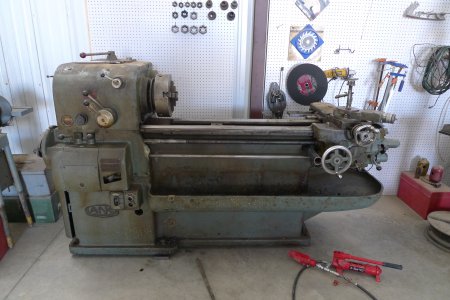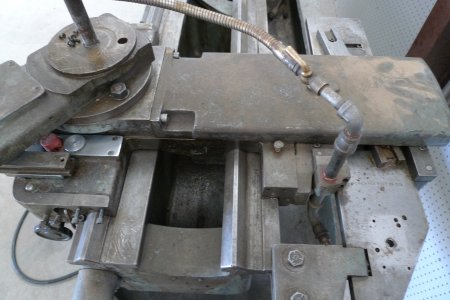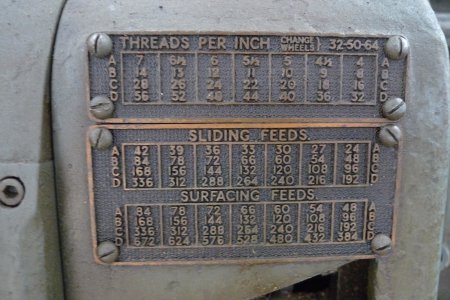- Joined
- Mar 27, 2014
- Messages
- 12
Hello,
I was given a Lang J6 lathe for some work I did. From my research, I believe it was made in or around 1950, and I have the 12 speed model. I got a reproduction manual with parts list. It is a wonderfully heavy machine, with a profile like that of an aircraft carrier and weight to match.
I am not completely new to lathes. I worked for about 8 months in a machine shop, beginning with sweeping the floors and cleaning machines and ending with doing a lot of OD profiling on large pieces (4" OD up to my biggest, roughing out a 30"OD x 30" long piece of steel), and some threading, and boring as well. I learned to do tapered ACME threads, some double start threads, and some multi-section threads too (not sure of the actual term, but on a single piece there were two sections of threads of equal TPI but on different diameters, and their start points had to match up).
My machine tool experience is therefore with large oil country engine lathes, but limited to keeping them oiled and clean (and not getting hurt). I never had to trouble shoot any issues, or really have any instruction in how to evaluate the working order of a machine. An intro to machining class would be great to provide some basic knowledge base, but I can't take one at this time.
Back to the J6:
- The older gentleman who had this machine for 30 something years was 98 years old when he finally sold his machine shop, and I got the lathe. In his later years he may have neglected maintenance. I have removed buckets and buckets of chips and rancid oil/cutting fluid from the lathe. There are brass cuttings everywhere. I understand that he was beginning to have issues doing good work with the lathe, but I do not know what the issues were and how significant they were. Electric had already been removed when we got it, so I have not seen it run.
- We have a rotary phase converter here at the shop, that I hope will be able to power the lathe.
- My intent for the lathe is to use it for some personal gunsmithing work, as well as prototyping work for projects I come up with. I don't need it to put food on the table.
- However, I need to get the lathe cleaned up and powered so that I can begin to identify problems, and get an idea of what it will cost to fix them. I have no money in it, and machines are not made like this any more, so I am not afraid to spend some money over the course of a year or so to get it serviceable. Heck, it may need nothing but a good cleaning and new felts and oil. (Well, I know the threading dial gear is broken - so it does need that at least)
Now, on to the questions: Where do I start? :think1: I built a heavy wood skid for transport which it has been sitting on (indoors )for 8 months - I just have not had time to work on it. I have a 4" Starett machinist level, and I can detect twist in the bed - my ways are not in the same plane. Could this be just due to the skid, and it will return to level once properly set on a pad?
I will put up some pictures and update my progress as I get it placed and wired.
Thanks for your interest,
Jonathan
I was given a Lang J6 lathe for some work I did. From my research, I believe it was made in or around 1950, and I have the 12 speed model. I got a reproduction manual with parts list. It is a wonderfully heavy machine, with a profile like that of an aircraft carrier and weight to match.
I am not completely new to lathes. I worked for about 8 months in a machine shop, beginning with sweeping the floors and cleaning machines and ending with doing a lot of OD profiling on large pieces (4" OD up to my biggest, roughing out a 30"OD x 30" long piece of steel), and some threading, and boring as well. I learned to do tapered ACME threads, some double start threads, and some multi-section threads too (not sure of the actual term, but on a single piece there were two sections of threads of equal TPI but on different diameters, and their start points had to match up).
My machine tool experience is therefore with large oil country engine lathes, but limited to keeping them oiled and clean (and not getting hurt). I never had to trouble shoot any issues, or really have any instruction in how to evaluate the working order of a machine. An intro to machining class would be great to provide some basic knowledge base, but I can't take one at this time.
Back to the J6:
- The older gentleman who had this machine for 30 something years was 98 years old when he finally sold his machine shop, and I got the lathe. In his later years he may have neglected maintenance. I have removed buckets and buckets of chips and rancid oil/cutting fluid from the lathe. There are brass cuttings everywhere. I understand that he was beginning to have issues doing good work with the lathe, but I do not know what the issues were and how significant they were. Electric had already been removed when we got it, so I have not seen it run.
- We have a rotary phase converter here at the shop, that I hope will be able to power the lathe.
- My intent for the lathe is to use it for some personal gunsmithing work, as well as prototyping work for projects I come up with. I don't need it to put food on the table.
- However, I need to get the lathe cleaned up and powered so that I can begin to identify problems, and get an idea of what it will cost to fix them. I have no money in it, and machines are not made like this any more, so I am not afraid to spend some money over the course of a year or so to get it serviceable. Heck, it may need nothing but a good cleaning and new felts and oil. (Well, I know the threading dial gear is broken - so it does need that at least)
Now, on to the questions: Where do I start? :think1: I built a heavy wood skid for transport which it has been sitting on (indoors )for 8 months - I just have not had time to work on it. I have a 4" Starett machinist level, and I can detect twist in the bed - my ways are not in the same plane. Could this be just due to the skid, and it will return to level once properly set on a pad?
I will put up some pictures and update my progress as I get it placed and wired.
Thanks for your interest,
Jonathan




